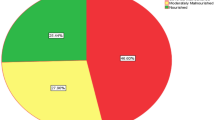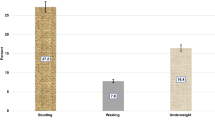Abstract
Objective: To compare the nutritional status of disabled children in Nigeria with their non-disabled siblings and neighbours. A second aim was to investigate anthropometric techniques appropriate for disabled children in this situation.
Design: A cross-sectional survey.
Setting: Nasarawa and Plateau States and the Federal Capital Territory in Central Nigeria.
Subjects: 311 children under 10 years of age were studied: 112 with various disabilities, 87 siblings and 112 neighbours.
Methods: Selected anthropometric measurements, (height, weight, mid-upper arm circumference (MUAC), demispan and halfspan), and blood haemoglobin levels were assessed by trained personnel. All measurements of disabled subjects were compared to the non-disabled controls.
Results: The disabled subjects had mean height for age (ht/age) and weight for age (wt/age) significantly lower than the control group (P<0.05). These differences were due largely to the very low Z scores in children with neurological impairments, (ht/age= 3.07 (s.d.=1.6); wt/age= 2.0 (s.d.=1.2)). Measurement difficulties contributed to low height values in disabled children and halfspan was found to be a useful proxy for height in these children. MUAC results were higher for the children with disabilities due to polio than for controls. The mean haemoglobin levels were slightly but significantly higher (P<0.05) in the disabled and sibling groups compared to the neighbourhood group.
Conclusion: Disabled children with neurological impairments and consequent feeding difficulties are nutritionally at risk, but others are no worse off than their non-disabled peers in this area. Halfspans may serve as a useful proxy indicator for estimating height in some children with physical impairments.
Sponsorship: The study was funded by a TEAR fund grant to JT for her MSc studies.
This is a preview of subscription content, access via your institution
Access options
Subscribe to this journal
Receive 12 print issues and online access
$259.00 per year
only $21.58 per issue
Buy this article
- Purchase on Springer Link
- Instant access to full article PDF
Prices may be subject to local taxes which are calculated during checkout
Similar content being viewed by others
Author information
Authors and Affiliations
Contributions
Contributors: J Tompsett supervised and conducted the field work and performed preliminary statistical analyses; A Yousafzai conducted further statistical analyses and drafted the paper; S Filteau supervised the overall study, contributed to the analysis and writing and is the guarantor for the work.
Rights and permissions
About this article
Cite this article
Tompsett, J., Yousafzai, A. & Filteau, S. The nutritional status of disabled children in Nigeria: a cross-sectional survey. Eur J Clin Nutr 53, 915–919 (1999). https://doi.org/10.1038/sj.ejcn.1600850
Received:
Revised:
Accepted:
Published:
Issue Date:
DOI: https://doi.org/10.1038/sj.ejcn.1600850
Keywords
This article is cited by
-
Comparison of armspan, arm length and tibia length as predictors of actual height of disabled and nondisabled children in Dharavi, Mumbai, India
European Journal of Clinical Nutrition (2003)



